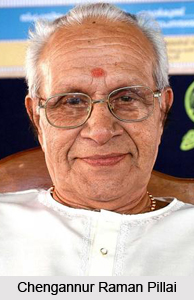 Chengannur Raman Pillai was a well renowned artist of Kerala. He was born in Chengannur, Kottayam district in 1885. He was the son of Kathakali make-up artist Pachu Pillai. At the age of 13, he joined the famous Thakazhi Kesava Panickers Kalari and also trained under Thakazhi Kochu Neelakandha Pillai, Ambalapuzha Kunju Krishna Panicker, `Damayanti` Nanu Pillai, and Mathur Kunju Pillai Panicker. At 20, he played the major part of Kichaka. In 1926, the Maharaja of Travancore appointed him as palace dancer, and he became the main guru in the royal Kathakali School where he gave importance and respect even to short roles. Without precedent, he reigned on the Kathakali stage for about seventy-five years, till the age of 89. He performed alongside his teachers, his contemporaries, and also his disciples. Chengannur always played the protagonist because none could surpass his acting.
Chengannur Raman Pillai was a well renowned artist of Kerala. He was born in Chengannur, Kottayam district in 1885. He was the son of Kathakali make-up artist Pachu Pillai. At the age of 13, he joined the famous Thakazhi Kesava Panickers Kalari and also trained under Thakazhi Kochu Neelakandha Pillai, Ambalapuzha Kunju Krishna Panicker, `Damayanti` Nanu Pillai, and Mathur Kunju Pillai Panicker. At 20, he played the major part of Kichaka. In 1926, the Maharaja of Travancore appointed him as palace dancer, and he became the main guru in the royal Kathakali School where he gave importance and respect even to short roles. Without precedent, he reigned on the Kathakali stage for about seventy-five years, till the age of 89. He performed alongside his teachers, his contemporaries, and also his disciples. Chengannur always played the protagonist because none could surpass his acting.
Chengannur Raman Pillai was not tall, but was handsome and had great flexibility. He excelled in katti characters like Ravana, Kichaka, Duryodhana, and young Narakasura, and roles of Balarama and Yudhishthira. For all of these roles he made his own costumes and crowns and also as Raudra like infuriated Bhima, Hamsa, and Hanuman. He believed in the actor`s freedom to interpret a role in his own style no matter who had trained or patronized him. His disciples include Harippati Ramakrishna Pillai, Chennithala Chellappan Pillai, Mankompu Sivasankara Pillai, and Madavoor Vasudevan Nair. He wrote a book on the Kaplingatu (southern) style, which he practiced. Greatly respected in the profession for his piety, he is said to have never counted the money he received for performances. Chengannur Raman Pillai died in 1980.
This article is a stub. You can enrich by adding more information to it. Send your Write Up to content@indianetzone.com



















